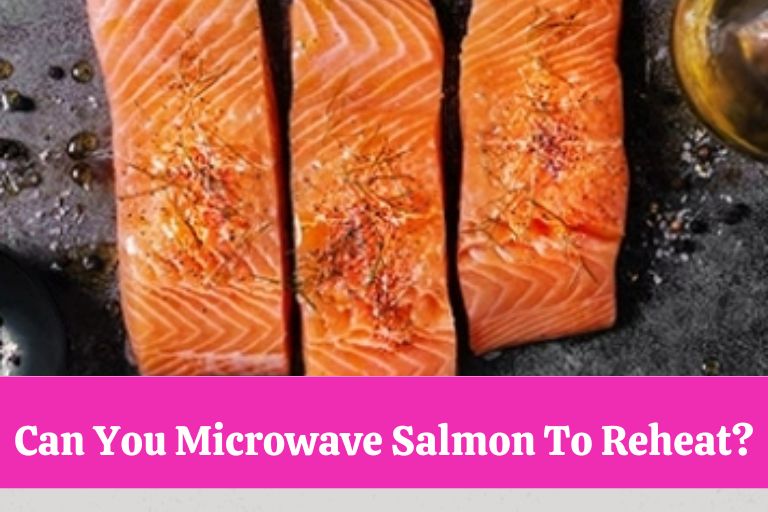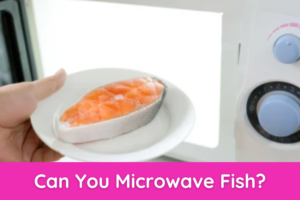Have you ever cooked salmon, only to find yourself wondering, can you microwave salmon to reheat it? Reheating cooked salmon can be tricky, but with the right technique and some know-how, it can be done safely.
In this article, we’ll discuss the best ways to reheat your leftover salmon to taste just as delicious as when it was first cooked. We’ll cover safety tips for microwaving fish and how long you should heat your meal before enjoying it again.
By the end of this article, you’ll have all the knowledge necessary to confidently answer, “If You can microwave salmon to reheat?”
Can You Microwave Salmon to Reheat?
No, it is not recommended to microwave salmon. While it is possible, it can result in unevenly cooked and rubbery food. Instead, it is better to reheat salmon in the oven or on the stovetop, as this will produce better results.
How do you reheat leftover salmon?
Reheating leftover salmon is best done in the oven or on the stovetop. Start by preheating your oven to 375 degrees Fahrenheit.
Place your leftover salmon on a parchment-lined baking sheet and bake until it reaches an internal temperature of 140 degrees Fahrenheit, usually 10 to 15 minutes, depending on the thickness of your salmon.
Alternatively, if you don’t have access to an oven, heat some oil in a skillet over medium heat, add the salmon, and cook for about 5 minutes or until it reaches an internal temperature of 140 degrees Fahrenheit.
Is it safe to eat reheated salmon?
Yes, it is safe to eat reheated salmon as long as proper steps are taken to ensure the safety of the fish.
- Make sure the salmon has been cooked thoroughly before placing it in the microwave
- Use a shallow microwavable dish
- Use paper towels to cover the dish before microwaving
- Heat medium heat for 3-5 minutes or until hot throughout.
Is it OK to microwave salmon?
Yes, it is safe to microwave salmon to reheat. When microwaving salmon, ensure the fish is completely cooked before consuming it. To ensure this, you can cover it with a lid or plastic wrap while gently stirring once during cooking. Ensure that the internal temperature of the salmon reaches at least 145°F before serving or consuming it.
Can I eat salmon cold the next day?
Yes, you can eat salmon cold the next day if it has been properly cooked and stored in the refrigerator. Ensure that the fish is not discolored or slimy before eating it.
Can you reheat and eat salmon the next day?
Yes, you can reheat and eat salmon the next day if it has been cooked properly and stored in the refrigerator. Make sure to check for any discoloration or sliminess before reheating. To do so: First, Use a shallow microwavable dish Second Cover the dish with paper towels; third, Heat on medium heat for 3-5 minutes or until hot throughout.
How do you keep salmon from exploding in the microwave?
To keep salmon from exploding in the microwave, wrap it loosely in moist paper towels or place it in a microwavable dish with just enough water to cover the bottom. Heat medium heat for 3-5 minutes or until cooked through. You can also use a specially designed splatter guard or plate cover when reheating fish in the microwave.
Is it rude to microwave salmon at work?
It depends on your workplace’s policies and culture, but in general, checking with your manager and colleagues before microwaving fish at work is recommended. Some places may have policies against reheating food with strong odors in the microwave, so it’s best to be considerate of others and find an alternative if possible.
Why does salmon spark in the microwave?
Salmon (and other types of fatty fish) can spark in the microwave because of electrical charges created within its fatty tissues. The microwaves create a charge between the molecules which can cause sparks that jump out and away from the fish. To reduce this, wrap the salmon loosely in paper towels or place it in a microwavable dish with just enough water to cover the bottom before cooking.
Can I refrigerate cooked salmon?
Yes, you can refrigerate cooked salmon. However, eating the salmon within two to three days of cooking is best for optimal flavor and texture. Cover or wrap the salmon tightly before putting it in the fridge.
How soon should you eat leftover salmon?
Leftover salmon should be eaten within three to four days of cooking. After that, the quality and flavor may suffer. To keep the cooked salmon fresh, store it properly in an airtight container or wrap it in plastic or aluminum foil.
How long is salmon good in the fridge?
Salmon is typically good in the fridge for up to two days before it loses its flavor and texture. It’s best to eat cold-smoked salmon within two weeks, while hot-smoked salmon will stay fresh for up to one month. To prolong its shelf life, store cooked salmon in an airtight container or wrap it tightly with plastic or aluminum foil.
How many times can salmon be reheated?
Salmon can be reheated up to two times. It is important to ensure that the fish reaches an internal temperature of at least 74°C (165°F). Reheat salmon quickly and evenly over medium-high heat, or place it in an oven preheated to 340°F (170°C) for 8–10 minutes.
What is the healthiest way to eat salmon?
The healthiest way to eat salmon is to bake, grill, or poach. Try baking or grilling your salmon with a few tablespoons of olive oil and herbs and spices such as garlic, paprika, or rosemary. Poaching is also an excellent option — place your salmon in a pan of lightly salted water and bring it to a slow simmer for 8–10 minutes.
Conclusion
Reheating salmon can be a great way to enjoy leftovers from the previous night. With just a few simple steps, you can safely and quickly reheat your cooked salmon in the microwave or oven without exploding or losing its flavor and texture.
Whether you bake, grill, poach, or even microwave your salmon for optimal health is up to you – whatever works best for your lifestyle!
We hope this article has provided helpful tips on properly heating leftover fish, such as salmon, so it remains delicious and safe for consumption. Do you have any other recommendations when it comes to reheating seafood? Let us know in the comments below!




